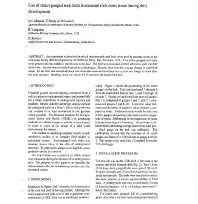Mining Publication: Use of Strain-Gauged Rock Bolts to Measure Rock Mass Strain During Drift Development
Original creation date: June 1999
An experiment is described in which instrumented rock bolts were used to measure strain in the rock mass during drift development at the Stillwater Mine, Nye, Montana, USA. Two strain-gauged rock bolts were grouted into the middle of the rib next to the face. The drift was excavated in three advances, each one-half drift wide. Strains were recorded hourly by a data logger. Results show that the average change in axial bolt strain for the first and second advance was about the same and that there was almost no change in strain after the third advance. Bending strain was observed 19 cm from the head of the bolt.
Authors: JC Johnson, TM Brady, MK Larson, RB Langston, H Kirsten
Conference Paper - June 1999
NIOSHTIC2 Number: 20028120
Rock Mechanics for Industry, Amadei, Kranz, Scott & Smeallie (eds), 1999 Jun, Balkema, Rotterdam, ISBN 90 5809 052 3; 497-502
See Also
- Calculation of Vertical Stress Exerted by Topographic Features
- Comparison of Ore Pass Computer Simulations for Designs Against Dynamic Load
- Deep Coal Longwall Panel Design for Strong Strata: The Influence of Software Choice on Results
- Development and Application of Reservoir Models and Artificial Neural Networks for Optimizing Ventilation Air Requirements in Development Mining of Coal Seams
- A Gas Pressure-Based Drift Round Blast Design Methodology
- Modeling and Prediction of Ventilation Methane Emissions of U.S. Longwall Mines Using Supervised Artificial Neural Networks
- Modernization and Further Development of the NIOSH Mine Emergency Response Training System (MERITS), Phase 1
- Rock Mechanics Study of Shaft Stability and Pillar Mining, Homestake Mine, Lead, SD (In Three Parts): 2. Mine Measurements and Confirmation of Premining Results
- Technology News 505 - NIOSH Releases New Coal Mine Roof Rating Software
- Technology News 516 - ARMPS-HWM: New Software for Sizing Pillars for Highwall Mining
- Page last reviewed: 9/21/2012
- Page last updated: 9/21/2012
- Content source: National Institute for Occupational Safety and Health, Mining Program


 ShareCompartir
ShareCompartir
